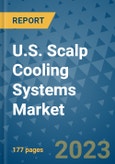Market Insights
According to a recent analysis, the U.S. scalp cooling systems market is forecasted to grow from US$ 31 million in 2025 to US$ 54 million by 2032, expanding at a robust CAGR of 8.25% during the forecast period. This growth is primarily attributed to technological innovation, the increasing geriatric population, and a heightened focus on patient-centric oncology care.Scalp cooling systems operate by reducing blood flow to hair follicles during chemotherapy, thus minimizing hair loss. This aspect of care has gained significance, particularly among breast cancer patients, where hair retention contributes significantly to emotional and psychological well-being.
Drivers Fueling Market Growth
The U.S. market for scalp cooling systems is benefitting from a number of key growth drivers:
- Technological Innovation: Modern scalp cooling systems now feature more advanced temperature controls and user-friendly interfaces, making them more efficient and accessible for clinical and at-home use.
- Regulatory Support: The U.S. Food and Drug Administration (FDA) has cleared several scalp cooling devices for use in clinical settings, encouraging adoption across oncology departments.
- Growing Cancer Burden: The steady rise in newly diagnosed cancer cases in the U.S., combined with a rapidly aging population, is increasing the demand for supportive treatment options.
- Increased Awareness: Enhanced awareness among both healthcare providers and patients about the benefits of scalp cooling is fueling demand, particularly in hospital and specialty clinic settings.
Business Opportunity
The market presents significant business potential for manufacturers and service providers. Rental sales have emerged as the most lucrative sales model, accounting for a significant share of market revenue. This model allows patients to access scalp cooling devices for the duration of their treatment without incurring high upfront costs. Manufacturers can benefit from this trend by expanding their rental networks and improving service accessibility across regions.Government support in the form of funding for cancer care and patient assistance programs has opened new doors for manufacturers to invest in research and development. Moreover, partnerships with hospitals and oncology centers are enabling wider distribution of advanced scalp cooling solutions.
Challenges to Consider
Despite the promising outlook, several hurdles remain:
- High Equipment Costs: The cost of installing and maintaining advanced scalp cooling systems remains high, particularly in smaller healthcare facilities.
- Training Requirements: Automated systems require skilled personnel to operate, and a shortage of trained professionals can limit adoption.
- Limited Penetration in Non-Metro Areas: Availability and awareness remain lower in rural and semi-urban regions, impacting the overall market reach.
Regional Analysis
Geographically, the market is segmented into the Northeast, Midwest, Southeast, Southwest, and West. While major metropolitan centers in the Northeast and West regions are leading in terms of adoption due to the presence of large cancer care centers, other regions are expected to witness increased deployment with rising healthcare investments.Key Players
The U.S. scalp cooling systems market remains a niche domain with a few prominent players leading technological advancements. These include:
- Paxman
- Dignitana AB
- Wishcaps
- Penguin Cold Caps
- Arctic Cold Caps LLC
- Chemotherapy Cold Caps, Inc.
- Warrior Caps
- Polar Cold Caps, LLC
- Cooler Heads Care
As patient-centered care continues to shape the future of oncology treatment in the United States, the scalp cooling systems market is expected to witness robust expansion. The combination of technological progress, supportive healthcare infrastructure, and evolving patient preferences is fostering a favorable environment for both existing and emerging market players.
Market Segmentation
By Product:
- Manual Cooling Systems/Cold Gel Caps
- Automated Cooling Systems
By Sales Type:
- Direct Sales
- Rental Sales
By End User:
- Hospitals
- Specialty Clinics
- Ambulatory Surgical Centers
- Homecare Settings
By Region:
- Northeast
- Midwest
- Southeast
- Southwest
- West
This product will be delivered within 1-3 business days.
Table of Contents
Companies Mentioned
- Paxman
- Dignitana AB
- Wishcaps
- Penguin Cold Caps
- Arctic Cold Caps LLC
- Chem
- Warrior Caps
- Polar Cold Caps, LLC.
- Cooler Heads Care, Inc.








